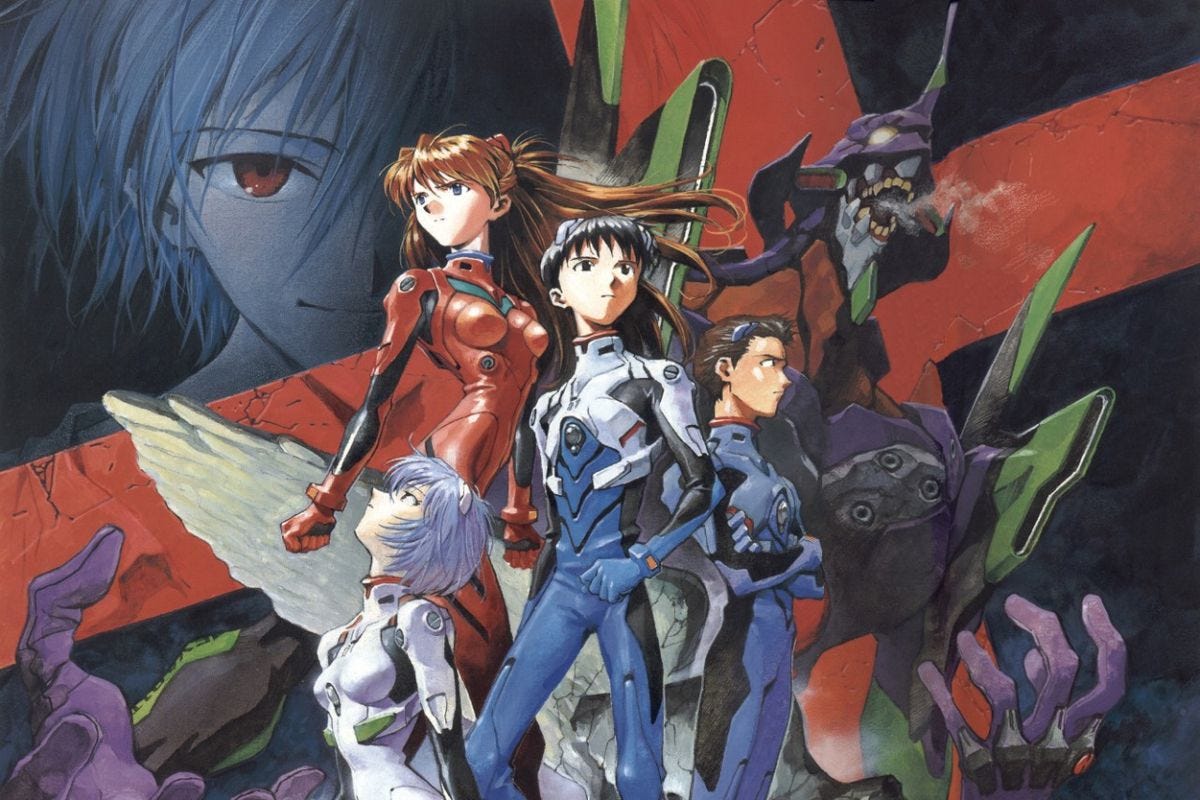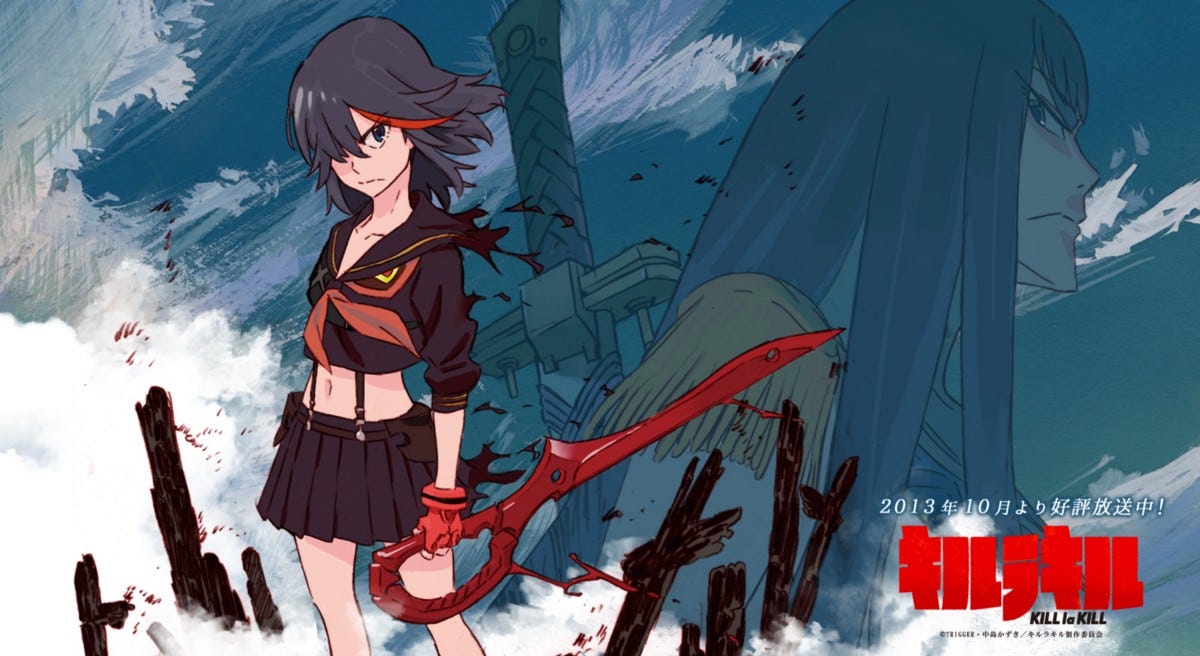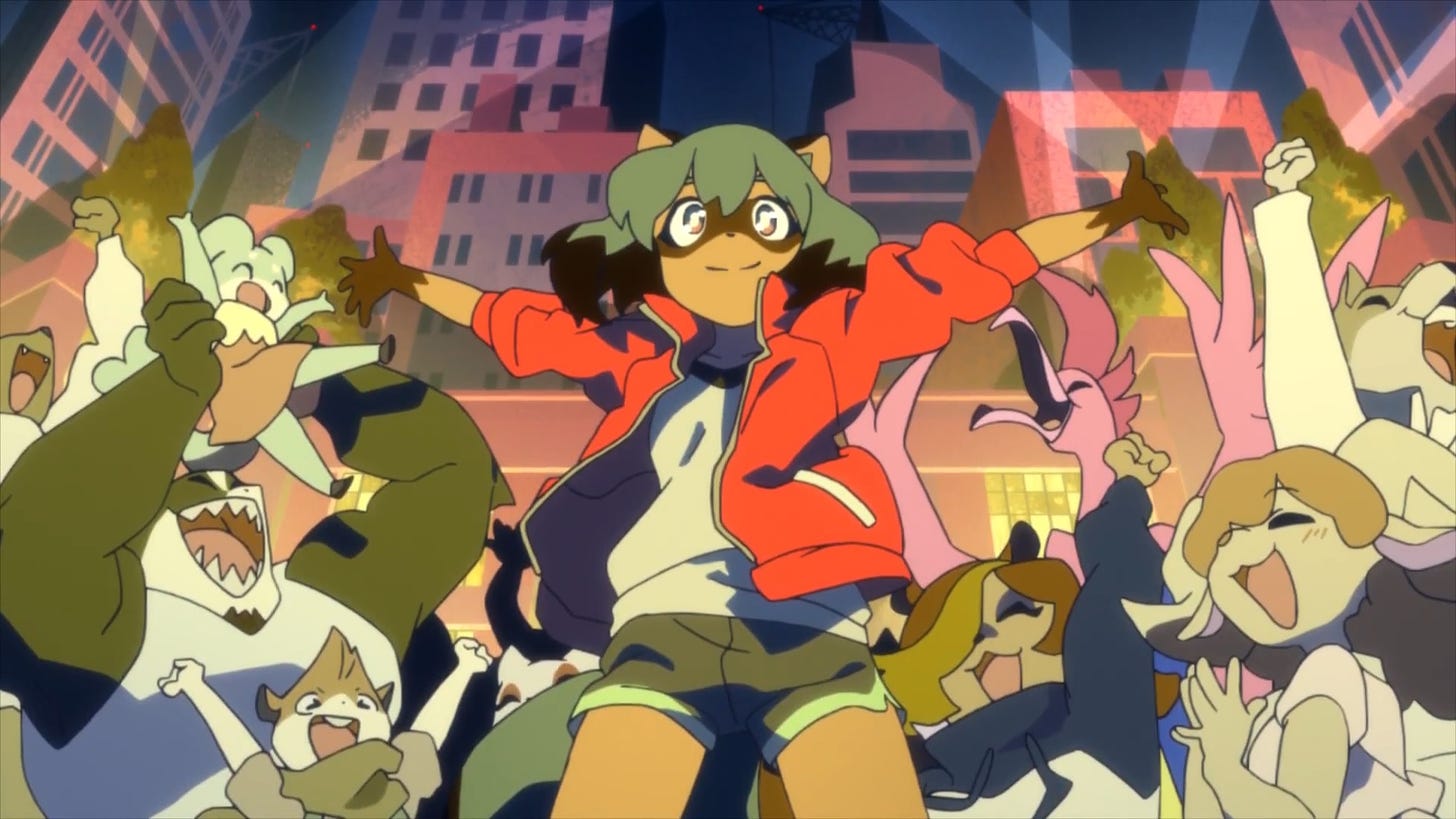This article on ‘How Studio Trigger Carries On The Legacy Of Gainax’ was available a week earlier through the Gamerbraves Newsletter. Sign up for free to gain access to more articles about news and trends in the gaming industry and community.
Original Article
Anime Studio Trigger recently launched their latest anime Cyberpunk: Edgerunners to rave reviews, including our own. The anime showed the full strengths of Trigger’s traits and talents: colorful stylized animation, bombastic action scenes, and surprisingly poignant character moments.
The Studio truly feels one of a kind and part of that comes from its roots in being the successor of one of the most important Anime studios in the industry: Gainax. Before Trigger was making Kill La Kill, BNA, and Little Witch Academia, Gainax was pumping out Neon Genesis Evangelion, Diebuster, and FLCL. All of these anime are known for their experimental ideas that play with audience expectations while also being filled with over-the-top action and fanservice.
Gainax unfortunately hasn’t made any new anime in quite some time with Trigger taking up the torch of eccentricity and strangeness. Here’s how Studio Trigger maintained that Gainax spirit that has its routes in the anime fandom itself.
The Origins in Otaku

Part of what makes Gainax’s so interesting is their origins. Nowadays for global fans the term ‘Otaku’ just means “anime fan” or “Japanese media fan” but Otaku in Japanese specifically refers to the overly obsessed fans that dedicated their lives to idolizing the craft of their subject of interest. I mention this because these were the people who founded Gainax.
Gainax was founded as Daicon Film in the 80s by a group of Anime/Tokusatsu Otaku at university. The group included names like Hideaki Anno, Yoshiyuki Sadamoto, Hiroyuki Yamaga, and Shinji Higuchi. Their first works were the Daicon III and IV openings, animated shorts for the Daicon Otaku Conventions. They featured numerous references to Godzilla, Ultraman, Star Wars, and many other objects of nerd fascination.
It made it clear from the start that these guys were otaku who wanted to make anime for like-minded people. What did that mean? It meant explosions, guns, cute girls, big boobs, and lots of in-jokes and references which can be seen in a number of their works like Diebuster, and Magical Shopping Arcade Abenobashi.

I’d personally recommend watching their two-episode OVA ‘Otaku No Video’ which is about a group of university Otaku starting an animation studio, heavily inspired by Gainax’s real-life founding cut between live-action interviews with real-life different Otaku, including an American who used all his savings to move to Japan and indulge in Otaku culture. This was clearly a culture that Gainax was a part of and wished to appeal to.
The Understanding of Otaku

These origins in Otaku culture also meant they understood the struggles of being an Otaku like loneliness and simply feeling like you can’t connect with other people.
Staff member Hideaki Anno was clinically depressed during the creation of his most well-known work: Neon Genesis Evangelion. Anno is often been accused of hating Otaku, but in reality, it’s the opposite. As an otaku himself, Anno says he wanted EVA to reach out to Otaku and show them that while anime is great, the world has a lot of other great things:
“I feel that otaku have already become common to all countries. In Europe, Korea, Taiwan, Hong Kong, in America, otaku really do not change. I think that this is amazing. Sometimes, I say critical things about otaku, but I don’t reject them. I only say that we should take a step back and be self-conscious about these things. I think it’s perfectly fine so long as you act with an awareness of what you are doing, self-conscious and cognizant of the current situation.” says Anno in a 2003 interview with Kodansha.
“I’m just not sure it’s a good thing to reach the point where you cut yourself off from society. I don’t understand the greatness of society, either. So I have no intention of going so far as to call for people to give up otaku-like things and become more suited to society. Only, I think there are many other interesting things in the world, and we don’t have to reject them.”
While a lot of anime studios likely have staff that are anime fans, none were as proud of their Otaku identity as Gainax. Uforntualy it wasn’t to last.
The Rise of Trigger

Unfortunately, many of Gainax’s key staff would leave the company. Their last project was an OVA of Masamune Datenicle which ended in 2018. They’re still around but haven’t made any new anime since.
Meanwhile, Studio Trigger was formed in 2011 by Hiroyuki Imaishi and Masahiko Ōtsuka, ex-Gainax staff the former of whom directed two of their biggest hits: Gurren Lagann and Panty And Stocking With Garterbelt.
The studio first made an OVA called Little Witch Academia showing their wide arrange of magical animation techniques. However, Trigger really started making deep cuts into the anime industry in 2013 with Kill La Kill, an anime that was very much alive with the old Gainax charm: swords, explosions, over-the-top characters, and anime boobs. It was one of the biggest hits of the year, with many memes calling it the “savior of anime”.
From there Trigger just kept on rolling with the same punk attitude running through their projects: Kiznaiver, Little Witch Academia, Darling In The Franxx, and SSSS. Gridman. While not all perfect they maintained that otaku spirit: balancing out the fun of anime with more meaningful topics of growing up, connecting with others, and finding acceptance in society: things that otaku need to hear.

All the while the company also remains open-minded to new ideas that keep the industry interesting. Like Gainax, they primarily work on original productions, always keeping fans guessing what they’re gonna do next.
They’ve also been keeping an eye out on otaku culture not only in Japan but around the world. Their collaborations with Disney’s Star Wars Visions and CD Project Red’s Cyberpunk Edgerunnners are a great example of this. The studio uniquely also has a Patreon where they hold sketch streams and connect with their fanbase even further.
Don’t Lose Your Way

Studio Trigger’s next project will be Gridman Universe, the third entry in the Gridman series. They haven’t revealed a lot about the plot but if it’s like previous entries we’ll see giant mecha, imposing kaiju, and a group of regular people trying to make their way through the world. The staples of Studio Trigger that were inherited from Gainax.
Studio Trigger remains an important part of the anime industry, partly because of how well they know their target audience and their willingness to both indulge them and speak to them. They fully embrace the good and bad of otaku culture both within their work and how they hold themselves on the outside.
To sum it up: Trigger is great because their animation is slick and bombastic, their stories are creative, and their characters are larger than life yet relatably human. Cyberpunk Edgerunners was one of the best anime I’ve seen all year and I’m excited to see what they come up with next.











![[SEA Exclusive] From Shadows to Shipwrecks – Jennifer English Talks About Bringing Emotional Depth to Clair Obscur: Expedition 33](https://cdn.gamerbraves.com/2025/04/Clair-Obscur-Jennifer-English_Interview_FI-360x180.jpg)

![[EXCLUSIVE] Do the Game Interview – An Intimate Look at the Challenges of Game Development](https://cdn.gamerbraves.com/2025/04/Do-the-Game_Interview_FI-1-360x180.jpg)
![[EXCLUSIVE] Interview with the Minds Behind of Den of Wolves – 10 Chambers’ New Sci-Fi Heist FPS](https://cdn.gamerbraves.com/2025/04/Den-of-Wolves_Interview_FI-360x180.jpg)










![[GUIDE] Finding Alma’s Lost Glasses in The Apple of Her Eye Side Quest](https://cdn.gamerbraves.com/2025/04/Alma-Glasses-Quest_Gudie_FI-360x180.jpg)



![[GUIDE] Farming Nightflower Pollen in Monster Hunter Wilds](https://cdn.gamerbraves.com/2025/03/MHWilds-Pollen_Guide_FI-360x180.jpg)